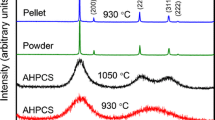Abstract
Attempts have been made to produce modified reaction-bonded silicon carbide (RBSC) ceramics by incorporating a dispersion of other phases into the initial powder mix. ZrC, TiC, TaC and B4C were chosen as additives together with TiB2 as a phase likely to produce microcrack toughening in the final compact. During fabrication an important factor appears to be the possible reactions of the added phase with liquid silicon during the infiltration stage of the process. Thus, while all the carbides react with liquid silicon to form refractory silicides and new silicon carbide, this only significantly affected the reaction-bonding process if the dissolution/reaction kinetics were so fast as to disrupt the formation of the new silicon carbide framework which grows epitaxially to bond the existing silicon carbide particles together. As with conventional RBSC, the initial SiC grits play no part in any reaction except to act as nucleation sites for the new SiC. The microstructures of the various new materials have been characterized by reflected light microscopy, scanning electron microscopy, energy dispersive X-ray analysis and X-ray diffraction. This has led to an appraisal of the high-temperature reactions observed to have occurred and the unreliability of the high-temperature thermochemical data used to predict their occurrence. The mechanical properties of the new materials have been investigated by indentation testing (hardness and fracture toughness), including temperature-variant tests. Results are presented and the possibility for improving the properties of RBSC are discussed.
Similar content being viewed by others
References
P. Popper, in “Special Ceramics” (Heywood Press, London, 1960) p. 209.
P. Kennedy, in “Non-Oxide Technical and Engineering Ceramics”, edited by S. Hampshire (Elsevier Applied Science, London, 1986) p. 301.
G. R. Sawyer andT. F. Page,J. Mater. Sci. 13 (1978) 885.
J. N. Ness andT. F. Page,ibid. 21 (1986) 1377.
C. W. Forrest, P. Kennedy andJ. V. Shennan, in “Special Ceramics 5”, edited by P. Popper (British Ceramic Research Association, Stoke-on-Trent, 1972) p. 99.
M. H. Lewis, G. Leng-Ward andC. Jasper, in “Proceedings of the 1st International Conference on Ceramic Powder Processing Science”, edited by G. L. Messing, E. R. Fuller and H. Hausner (American Ceramic Society, Westerville, OH, 1988) p. 1019.
K. Negita,J. Amer. Ceram. Soc. 69 (1986) C308.
D. Magley, R. A. Winholtz andK. T. Faber,ibid. 73 (1990) 1641.
A. J. Whitehead, T. F. Page andI. Higgins,Ceram. Engng Sci. Proc. 10 (1989) 1108.
M. G. S. Naylor, PhD thesis, University of Cambridge, UK (1981).
M. Hansen, “Constitution of Binary Alloys”, 2nd Edn (McGraw-Hill, London, 1958).
S. Prochazka, in “Proceedings of the 3rd International Conference on Silicon Carbide”, Miami, 17–20 September 1973, edited by R. C. Marshall, J. W. Faust Jr, and C. E. Ryan (University of South Carolina Press, Columbia, SC) p. 394.
N. W. Jepps andT. F. Page,J. Micros. 124 (1981) 227.
R. I. Scace andG. A. Slack,J. Chem. Phys. 30 (1959) 1551.
P. Kennedy, private communication (1987).
A. M. Stoneham andP. W. Tasker, “Designing Interfaces for Technological Applications”, edited by S. D. Peteves (Elsevier Applied Science, London, 1989) p. 217.
O. Kubaschewski andC. B. Alcock, “Metallurgical Thermochemistry”, 5th Edn (Pergamon Press, Oxford, 1979) p. 267.
JANAF (Joint Army, Navy, Air Force) Thermochemical Tables (National Bureau of Standards, Washington, DC, 1971).
D. A. Robins andI. Jenkins,Acta Metall 3 (1955) 598.
S. G. Davis, D. F. Apthrop andA. W. Searcy,J. Chem. Phys. 34 (1961) 659.
C. E. Meyers andA. W. Searcy,J. Amer. Chem. Soc. 79 (1957) 526.
P. M. Sargent, PhD thesis, University of Cambridge, UK (1979).
S. J. Bull, T. F. Page andE. H. Yoffe,Phil. Mag. Lett. 59 (1989) 281.
P. Schwarzkopf andR. Kieffer, “Refractory Hard Metals: Borides, Carbides, Nitrides and Silicides” (Macmillan, New York, 1953) p. 328.
A. G. Atkins, A. Silvéro andD. Tabor,J. Inst. Metals 94 (1966) 369.
J. A. Yeomans, PhD thesis, University of Cambridge, UK (1986).
G. R. Anstis, P. Chantikul, B. R. Lawn andD. B. Marshall,J. Amer. Ceram. Soc. 64 (1981) 533.
J. N. Ness, PhD thesis, University of Cambridge, UK (1985).
Author information
Authors and Affiliations
Rights and permissions
About this article
Cite this article
Whitehead, A.J., Page, T.F. Fabrication and characterization of some novel reaction-bonded silicon carbide materials. J Mater Sci 27, 839–852 (1992). https://doi.org/10.1007/BF02403904
Received:
Accepted:
Issue Date:
DOI: https://doi.org/10.1007/BF02403904



